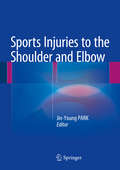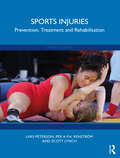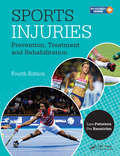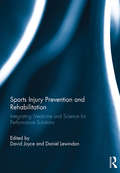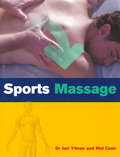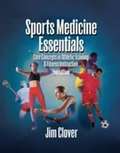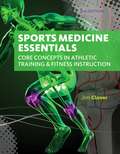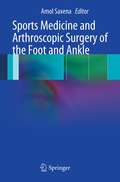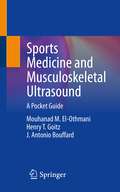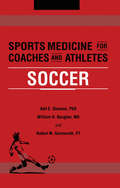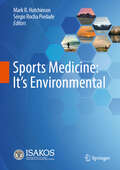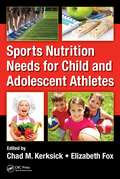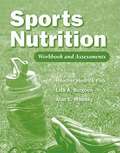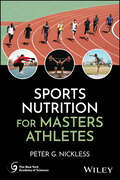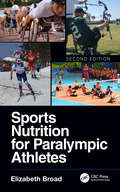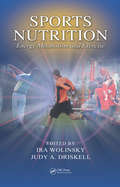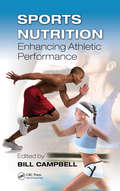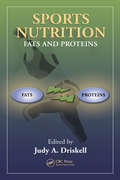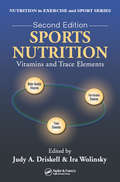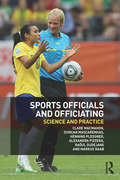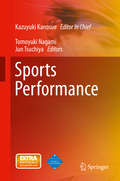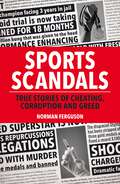- Table View
- List View
Sports Injuries to the Shoulder and Elbow
by Jin-Young ParkThis book documents current knowledge on the mechanisms involved in sports injuries to the shoulder and elbow, reviews essential physical examinations, and explains the role of diagnostic imaging. Above all, it describes in detail the treatment modalities that are appropriate to the injuries encountered in throwing and overhead athletes, including chronic repetitive and acute traumatic injuries. Both conservative and surgical treatments are covered; the author's own preferred operative techniques are identified and explained, and helpful treatment algorithms offer guidance in selecting an approach fitting to the circumstances. In addition, the inclusion of instructive case reviews will assist readers in achieving a full understanding of the implementation of treatment protocols. Methods of rehabilitation are also described with the aid of demonstration videos, and advice is provided on appropriate timing. The book will be invaluable for all professionals who deal with sports injuries of the shoulder and elbow, including surgeons, physiotherapists, other medical practitioners, and trainers.
Sports Injuries: Prevention, Treatment and Rehabilitation
by Scott Lynch Lars Peterson Per A.F.H. RenstromAs more people realize the cardiovascular, metabolic and muscular benefits that regular physical activity provides, the risk for potential injury also increases. To provide successful treatment, all persons involved in the management of injuries must have a thorough understanding of the healing process of the various tissues and also be familiar with the demands of different types of sports. Written by three world-renowned experts, Sports Injuries, Fifth Edition, comprehensively covers the prevention, treatment and rehabilitation of sports injuries. Essential reading for all athletes, coaches/trainers, physiotherapists and doctors, the updated edition of this highly popular and well-established textbook skillfully integrates scientific background and evidence with practical application. Updated topics covered include: Individual risk factors for sports injuries Effects of physical inactivity on the tissues Head and face injuries in sport Cervical, thoracic and abdominal injuries in sport Back and spine injuries in sport Leg, knee and thigh injuries Outdoor activities during extreme conditions Ethical considerations in sports and exercise medicine Injuries in sport for the disabled, growing and aging athletes Richly illustrated with more than 600 color drawings and photographs, this book covers injuries resulting from the full range of international sports. For each type of injury examined, it details the symptoms, mechanism of injury, diagnosis, treatment, rehabilitation protocols and key points – clearly stating what both non-medical and medical professionals should do in each case of injury. This easy-to-follow textbook features a glossary of key terms and protocols with rehabilitation exercises to provide readers with a solid understanding about how to effectively treat, rehabilitate and prevent sports injuries. This book will be of key reading to academics and students of sport medicine, sport injury, physiotherapy and sports rehabilitation as well as related disciplines.
Sports Injuries: Prevention, Treatment and Rehabilitation
by Scott Lynch Lars Peterson Per A.F.H. RenstromAs more people realize the cardiovascular, metabolic and muscular benefits that regular physical activity provides, the risk for potential injury also increases. To provide successful treatment, all persons involved in the management of injuries must have a thorough understanding of the healing process of the various tissues and also be familiar with the demands of different types of sports.Written by three world-renowned experts, Sports Injuries, Fifth Edition, comprehensively covers the prevention, treatment and rehabilitation of sports injuries. Essential reading for all athletes, coaches/trainers, physiotherapists, nurses and doctors, the updated edition of this highly popular and well-established textbook skillfully integrates scientific background and evidence with practical application. Updated topics covered include: Individual risk factors for sports injuries Effects of physical inactivity on the tissues Head and face injuries in sport Cervical, thoracic and abdominal injuries in sport Back and spine injuries in sport Leg, knee and thigh injuries Outdoor activities during extreme conditions Ethical considerations in sports and exercise medicine Injuries in sport for the disabled, growing and aging athletes Richly illustrated with more than 600 color drawings and photographs, this book covers injuries resulting from the full range of international sports. For each type of injury examined, it details the symptoms, mechanism of injury, diagnosis, treatment, rehabilitation protocols and key points – clearly stating what both non-medical and medical professionals should do in each case of injury. This easy-to-follow textbook features a glossary of key terms and protocols with rehabilitation exercises to provide readers with a solid understanding about how to effectively treat, rehabilitate and prevent sports injuries. This book will be of key reading to academics and students of sport medicine, sport injury, physiotherapy and sports rehabilitation as well as related disciplines.
Sports Injuries: Prevention, Treatment and Rehabilitation, Fourth Edition
by Lars Peterson Per A.F.H. RenstromAs more and more people realize the cardiovascular, metabolic, and muscular benefits that regular physical activity provides, the risk for potential injury also increases. In order to provide successful treatment, all persons involved in the management of injury must have a thorough understanding of the healing process of the various tissues and also be familiar with the demands of different types of sports.Written by two world-renowned experts, Sports Injuries, Fourth Edition comprehensively covers the prevention, treatment, and rehabilitation of sports injuries. Essential reading for all athletes, coaches/trainers, physiotherapists, and doctors, the updated edition of this highly popular and well-established textbook skillfully integrates scientific background and evidence with practical application. Topics covered include: Individual risk factors for sports injuries Effects of physical inactivity on the tissues Head and face injuries in sport Cervical, thoracic and abdominal injuries in sport Back and spine injuries in sport Outdoor activities during extreme conditions Sports injuries of the lower and upper extremities Injuries in sport for the disabled Richly illustrated with more than 650 color drawings and photographs, this book covers injuries resulting from the full range of international sports. For each type of injury examined, it details the symptoms, mechanism of injury, diagnosis, treatment, rehabilitation protocols, and key points—clearly stating what both non-medical and medical professionals should do in each case of injury. This easy-to-follow textbook features a glossary of key terms and protocols with rehabilitation exercises to provide readers with a solid understanding about how to effectively treat, rehabilitate, and prevent sports injuries.
Sports Injury Prevention and Rehabilitation: Integrating Medicine and Science for Performance Solutions
by David Joyce Daniel LewindonWorld-class rehabilitation of the injured athlete integrates best practice in sports medicine and physical therapy with training and conditioning techniques based on cutting-edge sports science. In this ground-breaking new book, leading sports injury and rehabilitation professionals, strength and conditioning coaches, biomechanists and sport scientists show how this integrated model works across the spectrum of athlete care. In every chapter, there is a sharp focus on the return to performance, rather than just a return to play. The book introduces evidence-based best practice in all the core areas of sports injury risk management and rehabilitation, including: performance frameworks for medical and injury screening; the science of pain and the psychology of injury and rehabilitation; developing core stability and flexibility; performance retraining of muscle, tendon and bone injuries; recovery from training and rehabilitation; end-stage rehabilitation, testing and training for a return to performance. Every chapter offers a masterclass from a range of elite sport professionals, containing best practice protocols, procedures and specimen programmes designed for high performance. No other book examines rehabilitation in such detail from a high performance standpoint. Sports Injury Prevention and Rehabilitation is essential reading for any course in sports medicine and rehabilitation, strength and conditioning, sports science, and for any clinician, coach or high performance professional working to prevent or rehabilitate sports injuries.
Sports Massage
by Mel Cash Dr Jari YlinenSports therapy has made huge advances in recent years and is no longer the preserve of the professional athlete.More and more people who take part in sport at all levels are seeking treatment from masseurs and other therapists for injury or the fatigue that follows intensive training. This landmark book is the first to set out in full the techniques and routines involved in sports massage, as well as guidance on the treatment of specific injuries related to various sports.This book explains how sports massage improves and speeds up a sportsman's recovery from training, which sports injuries can be effectively treated by massage, and how quickly it can be applied.Based on sound medical principles, and with over 200 specially commissioned photographs and illustrations, Sports Massage sets out the skills and techniques of sports massage for physiotherapists, coaches, trainers and keen sportsmen themselves.Also included are sections on stretching, self-massage, Shiatsu and acupressure.
Sports Medicine Essentials: Core Concepts in Athletic Training & Fitness Instruction
by Jim CloverSports Medicine Essentials: Core Concepts in Athletic Training, Second Edition introduces students to potential careers in the Sports Medicine field, from Fitness Instructor to Athletic Trainer. This comprehensive text surveys a broad scope of knowledge related to the Sports Medicine field, encompassing fitness assessment, conditioning, emergency preparedness, injury management, therapeutic modalities, nutrition, ethical and legal considerations and much more. To help introduce students to an array of exciting careers, it features enrichment activities that include researching the cost of sports medicine supplies, demonstrate taping techniques, and the forming of a safety committee to devise a plan to minimize risk to a team, athletes or clients. This complete resource is a fantastic introduction for any program.
Sports Medicine Essentials: Core Concepts in Athletic Training & Fitness Instruction
by Jim CloverCorrelating with NATA Standards, SPORTS MEDICINE ESSENTIALS: CORE CONCEPTS IN ATHLETIC TRAINING & FITNESS INSTRUCTION, 3rd Edition introduces essential skills in Sports Medicine, along with its growing number of career choices. Key topics address fitness assessment, conditioning, emergency preparedness, injury management, therapeutic modalities, nutrition, ethical and legal considerations, and much more. Students will explore careers in fitness instruction, athletic training, exercise physiology, sports management, and even physical therapy, while practicing important, job-related skills. More than a text, this unique hands-on learning tool asks students to perform essential skills, such as taping injuries, researching sports medicine supplies and their costs, and even forming a mock safety committee to mitigate injury risks to athletes. SPORTS MEDICINE ESSENTIALS: CORE CONCEPTS IN ATHLETIC TRAINING & FITNESS INSTRUCTION, 3rd Edition gives students VIP access to the fast-paced world of Sports Medicine in both print and interactive eBook formats.
Sports Medicine and Arthroscopic Surgery of the Foot and Ankle
by Amol SaxenaSports Medicine is now a specialty in its own right. The Olympics are coming to the UK which has focused interest in the field, and pain in elite sport is an unresolved issue. Sports Medicine is an area that has expanded dramatically in the last 5 years, and demand for educational materials to help bridge the gap in the literature are highly sought-after. This book utilises the excellent sports medicine section originally published within International Advances in Foot and Ankle Surgery and present it in a quick reference format for residents and trainees in orthopedic sports medicine. The information presented covers current accepted techniques with scientific rationale and will appeal to all surgeons and health care professionals with an interest in sports medicine. This is a truly international, multidisciplinary manual of foot and ankle surgery in sports medicine by the specialty's leaders and most experienced surgeons. Current up to date trends and techniques using a scientific approach including evidence based guidelines where applicable are included. The reader will be exposed to a step-by-step approach to each procedure presented.
Sports Medicine and Musculoskeletal Ultrasound: A Pocket Guide
by Mouhanad M. El-Othmani Henry T. Goitz J. Antonio BouffardIdeal for all practitioners of musculoskeletal medicine, this practical pocket guide provides a standardized approach, through detailed checklists and protocols, for a complete ultrasonographic examination of the musculoskeletal system to assist in the diagnosis and management of orthopedic and sports medicine pathologies. As the trend in the US healthcare system continues to move towards optimizaing value in care delivery, the utilization of ultrasound has been in the spotlight as a cost-efficient and accurate diagnostic modality for musculoskeletal pathology Ultrasound assessment remains user-dependent, and multiple pathologies can often be overlooked due to the lack of a standardized approach to assess a specific joint or anatomic structure. To address this challenge, this user-friendly text presents a quick, accessible, and structured approach for a complete sonographic examination. After a general overview of the use of ultrasound in musculoskeletal medicine, each chapter proceeds anatomically and includes a detailed, step-by-step approach to the ultrasound diagnostic assessment, covering all major joints and pathologies of clinical importance: shoulder, elbow, hand and wrist, hip, knee, and foot and ankle. Plentiful images support this stepwise approach, covering the entire spectrum from patient positioning to ultrasound findings and appearance. Students, residents, and fellows in orthopedics and sports medicine will find this text especially valuable, however all healthcare providers dealing with the diagnosis and management of musculoskeletal conditions will benefit from its clear and concise approach.
Sports Medicine for Coaches and Athletes: Soccer (Sports Medicine For Coaches And Athletes Ser. #Vol. 1)
by Adil E. Shamoo William H. Baugher Robert M. GermerothThis book is a practical guide and concise sports medicine reference, written exclusively for the sport of soccer. Based on Adil Shamoo's notes from years of coaching, teaching, and lecturing on the subject, this succinct handbook approaches soccer from a unique scientific perspective. The experiences of Dr. Shamoo and coauthors William Baugher, a sports medicine orthopedist, and Robert Germeroth, a physical therapist, combine to make the latest sports medicine research relevant and accessible to those who participate in the sport. Coaches, referees, players, parents, and athletic trainers from grade school through college will find the authors' knowledgeable discussion of soccer injuries to be an invaluable resource for prevention and treatment. Sports retailers, pediatricians and professionals in the field of sports medicine will also appreciate the book's comprehensive coverage of the physical, mental, and nutritional aspects of playing the game of soccer, the world's most popular sport.
Sports Medicine for the Emergency Physician
by Anna L. WaterbrookWritten by sports-trained emergency physicians Sports Medicine for the Emergency Physician: A Practical Handbook is the only resource of its kind, created specifically for the emergency medicine provider. It is designed to be used as a reference tool, and includes high-yield physical exam skills and key management of sport injuries in the emergency department. Each chapter is dedicated to a specific joint (or joints) and includes the basics of a high-yield physical examination including inspection, palpation, range of motion, special tests, as well as neurovascular and skin exams. Corresponding figures of essential anatomy, pictures of physical exam maneuvers, and clinical correlations are also featured. Emergent and common musculoskeletal conditions for each joint(s) are discussed, as well as the appropriate emergency department management for each condition. Additional chapter topics include sports concussions, sports cardiology, heat illness, and common splints used in the emergency department.
Sports Medicine: It's Environmental
by Sérgio Rocha Piedade Mark R. HutchinsonThis book serves as an essential quick reference for team physicians, focusing on the risks associated with athletic participation in various environments. It covers a wide range of environmental challenges, including heat, cold, UV exposure, bad weather such as lightning and hurricanes, mountainous and high-altitude conditions, wet and isolated environments, crowded mass sporting events, dangerous situations, contagious diseases, indoor settings, and polluted air and water quality. The book follows a consistent structure to facilitate easy cross-referencing, including clinical pearls for identifying environment-related injuries or diseases, recommended initial treatment responses, and guidelines for extraction from pathological environments. The reader will find each chapter featuring learning objectives and key reading references. This practical manual offers the reader an essential tool to navigate the complexities of environmental medicine in sports, ensuring the health and safety of athletes in any setting.
Sports Medicine: Prevention, Evaluation, Management, and Rehabilitation (2nd edition)
by Richard Irvin Steven RoyAcclaimed for its accuracy and comprehensive style, Sports Medicine has been a favorite in the field for years. The second edition of this book continues this tradition while reflecting the latest trends in the field. <P>Designed to provide an understanding of the injury process, this contemporary volume includes coverage on the subjects of prevention, assessment, First Aid, nutrition, treatment and rehabilitation of sports-related injuries. It provides clinicians with an invaluable reference on the anatomy, pathology, short term care, and long-term care of injuries. This book meets the requirements of the National Athletic Trainer Association.
Sports Nutrition Needs for Child and Adolescent Athletes
by Elizabeth Fox Chad M. KerksickAs the number of child and adolescent athletes continues to increase each year, more children are being exposed to greater training volumes and increasing physical demands-making the need for nutritional and recovery guidance increasingly important. While massive amounts of empirical research are published each year on responses and adaptations to
Sports Nutrition Workbook and Assessments
by Heather Hedrick Fink Lisa A. Burgoon Alan E. MikeskySports Nutrition Workbook and Assessments provides expanded or alternative activities that will broaden students' understanding of sports nutrition. The workbook can be used as a standalone or in conjunction with the Third Edition of Practical Applications in Sports Nutrition.
Sports Nutrition for Masters Athletes (New York Academy of Sciences)
by Peter G. NicklessDiscover the nutritional and physiological age-related changes and needs of athletes aged 35 and above Athletic activity is becoming increasingly central to the lives of many adults as they age. More and more adults over 35 participate actively in athletics. Additionally, older adults are increasingly encouraged to pursue athletics for reasons of health and wellness. There is a growing need, therefore, for sports nutrition and physiology texts that focus on this population in detail, and not simply as a subset of a field that has been primarily oriented towards younger athletes. Sports Nutrition for Masters Athletes meets this need with an intensive, evidence-based approach to the nutritional needs of athletes over the age of 35. Alert to the importance of diet in performance and the requirements of older athletes, the book offers a robust toolkit for maintaining athletic performance with age while adjusting for physiologic changes. The result is an essential contribution to a growing field of research and clinical practice. Sports Nutrition for Masters Athletes readers will also find: An overview of physiological changes associated with the aging process and their impact on performance. Detailed insights into the relationship between nutrition and the mitigation of the inflammatory process. Coverage of subjects including the determination of caloric and nutrient needs, dietary strategies, and many more Sports Nutrition for Masters Athletes is ideal for those pursuing education in nutrition, exercise science, exercise physiology, health and wellness, and physical education. It will also be of interest to those studying physical aging or work with older adults as clients and patients.
Sports Nutrition for Paralympic Athletes, Second Edition
by Elizabeth BroadSports participation opportunities for individuals with impairments are increasing. Whether an athlete is beginning a sport or competing on the world stage for a podium finish, nutrition is recognized as being integral to optimizing their health, training capacity, and performance. Some athletes with impairments are physiologically similar to their able-bodied counterparts, whereby the application of sports nutrition principles is straightforward. However, athletes with certain impairments require a very individualized approach when applying these principles in a practical way. Fully updated and expanded, this second edition of Sports Nutrition for Paralympic Athletes is an essential resource for sports nutrition practitioners who work alongside athletes with an impairment, whether that be physical, visual, hearing, or intellectual. In addition to chapters devoted to each impairment type, this book covers specific areas including medical considerations, body composition, supplements, and practical aspects that can be applied across all athletes and sports. Case studies and messages from athletes and world-class coaches enhance the application of theoretical research into practice providing the most relevant sports nutrition advice to Para athletes. Features New chapters on energy availability in Para athletes and cooling and hydration for the Para athlete Concise review of current sports nutrition recommendations for athletes, both during training and in competition Provides practical guidance and examples on how to apply sports nutrition principles to each impairment type Includes real life experiences of Para athletes, elite coaches, and practitioners Encompasses wider topics of assessing body composition, medical considerations, and supplement use specific to Para athletes Features insight and experiences gained by practitioners over the three major Paralympic Games since the first edition Sports nutrition can be the difference between being competitive and making the podium. With the rapidly increasing Paralympic profile, this book is valuable for professionals endeavoring to give their athletes the competitive edge - it challenges, stimulates, and drives future research in this area to continue to improve the delivery of this intrinsic component of athlete preparation.
Sports Nutrition: Energy Metabolism and Exercise (Nutrition in Exercise & Sport)
by Ira Wolinsky Judy A. DriskellExercise by itself tears down the body. To rebuild that body so that it expresses greater strength, endurance, and speed, requires sound nutritional practices based on fact rather than fad. Those practices must also recognize that specific needs vary greatly according to age, gender, and intensity of exercise.Sports Nutrition: Energy Metabo
Sports Nutrition: Enhancing Athletic Performance
by Bill I. CampBellWith the constant flow of information related to sports nutrition coming from scholarly journals, it is difficult to sift through it all and determine what is relevant. Sports Nutrition: Enhancing Athletic Performance helps in this endeavor, with more than 1,000 references from top academic journals, offering critical knowledge concerning nutrient
Sports Nutrition: Fats and Proteins
by Judy A. DriskellIt is well known that fats, proteins, and carbohydrates are all energy-yielding nutrients that influence health and physical performance. Yet many recreational, collegiate, and professional athletes still consume more fats, saturated fats, and cholesterol than is recommended, as well as inappropriate amounts of proteins. What is needed is a nuts an
Sports Nutrition: Vitamins and Trace Elements, Second Edition
by Judy A. Driskell Ira WolinskyIn competitive sports where an extra breath or a millisecond quicker neural response can spell the difference between fame and mediocrity, a number of myths have persisted around the impact of what might be considered megadoses of various vitamins and trace elements. We do know that a growing body of research indicates that work capacity, oxygen co
Sports Officials and Officiating: Science and Practice
by Henning Plessner Markus Raab Clare MacMahon Duncan Mascarenhas Alexandra Pizzera Raôul OudejansSports officials (umpires, referees, judges) play a vital role in every sport, and sports governing bodies, fans, and players now expect officials to maintain higher professional standards than ever before. In this ground-breaking book, a team of leading international sport scientists and top level officials have come together to examine, for the first time, the science and practice of officiating in sport, helping us to better understand the skills, techniques and physical requirements of successful refereeing. The book covers every key component of the official’s role, including: Training and career development Fitness and physical preparation Visual processing Judgement and decision-making Communication and game management Psychological demands and skills Using technology Performance evaluation Researching and studying officials in sport Top-level officials or officiating managers contribute in the ‘Official’s Call’ sections, reflecting on their experiences in real in-game situations across a wide range of international sports, and on how a better understanding of science and technique can help improve professional practice. No other book has attempted to combine leading edge contemporary sport science with the realities of match officiating in this way, and therefore this book is vital reading for any advanced student of sport science, sport coaching or sport development, or any practising official or sports administrator looking to raise their professional standards.
Sports Performance
by Kazuyuki Kanosue Tomoyuki Nagami Jun TsuchiyaThis book focuses on sports performance. According to the Longman Dictionary of Contemporary English, "performance" refers to "how well or badly a person, company etc. does a particular job or activity" and "high performance" describes "cars, computers etc. that are able to go faster, do more work etc. than normal ones". In the 100-m dash Usain Bolt is indubitably the fastest person in history and Javier Sotomayor, the world record holder in the high jump, has exhibited the highest level of performance in this event. In these contests, the index of sports performance is unitary; it is simply the time or the jumping/throwing distance. What is it that allows such performers to achieve the fastest running time or the highest jump? One of the topics covered in this book is an attempt to clarify some of the unique motor skills and/or physical abilities that underlie such high performances. This book comprises a compilation of updated reviews on performance in various sports, including both basic and applied research and is divided into three parts. The central theme of Part I is the brain. Basic research on human locomotion, motor imagery, and cognitive function are included in this part. In Part II, the focus is on basic information involving high performance in sports, including the athletes' physiology, genetics, nutrition and biomechanics. In Part III, entitled "Performance and Coaching in Various Sports", the latest findings involving skills and performance in individual sports are presented. These performances are thoroughly described and to the extent possible, explained utilizing observations that involve applied biomechanics, coaching science and information technology. In the e-book version, videos and images are available, which provide valuable information on movement in sports. This book will awaken a deeper and more sophisticated interest in exceptional sports performance, not only in specialists such as researchers, athletes, and coaches, but also in laypeople who enjoy participating in and watching sports.
Sports Scandals: True Stories of Cheating, Corruption and Greed
by Norman FergusonThe high-pressure world of competitive sport has been shaken over the years by a series of major scandals involving drugs, sex, violence, money or pure and simple cheating. Highlighting memorable cases from around the world, Norman Ferguson explores recent and historic instances of outrageous unsporting behaviour.
